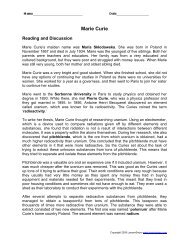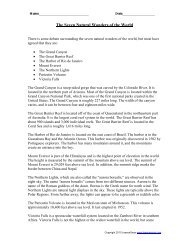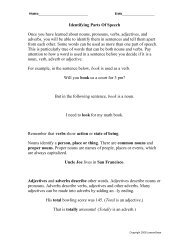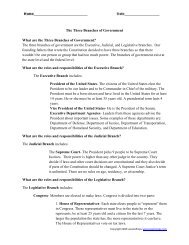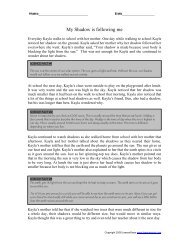Sumer - LessonSnips
Sumer - LessonSnips
Sumer - LessonSnips
Create successful ePaper yourself
Turn your PDF publications into a flip-book with our unique Google optimized e-Paper software.
Reading and Discussion<br />
<strong>Sumer</strong><br />
Around 3500 BCE, a civilization known as <strong>Sumer</strong> developed in Mesopotamia. Most of<br />
what is known about <strong>Sumer</strong> is due to the findings of archaeologists. In 1927,<br />
archaeologists unearthed the ancient <strong>Sumer</strong>ian city of Ur. Based on their findings, we<br />
know that the <strong>Sumer</strong>ians had powerful city-states. A city-state is a city that is a state<br />
unto itself. This means that it has its own government, and it is not controlled by any<br />
larger state or governing body.<br />
Some <strong>Sumer</strong>ians lived outside of the actual city. They farmed and raised pigs, sheep,<br />
and oxen. The crops received water from the rivers by using a complex network of<br />
canals. While the farmers lived outside of the city, merchants, artisans, and trades<br />
people lived in the city.<br />
<strong>Sumer</strong>ian society was made up of different classes. The upper class was made up of<br />
priests, government officials, rich landowners, nobles, and kings. The middle class<br />
included farmers, merchants, trades people, artisans, and soldiers. The lowest class<br />
was made up of slaves.<br />
The <strong>Sumer</strong>ian civilization is credited with inventing the wheel. The <strong>Sumer</strong>ian civilization<br />
also had the earliest known written language. Their language used a form of wedgeshaped<br />
characters called cuneiform. Using the sharp end of reeds, <strong>Sumer</strong>ians<br />
scratched the cuneiform symbols into tablets made out of clay. <strong>Sumer</strong>ians used these<br />
clay tablets to write religious works, legal documents, and literary works. This is known<br />
because archaeologists have managed to dig up thousands cuneiform tablets.<br />
<strong>Sumer</strong>ians were also builders. They built ziggurats, which are pyramid-shaped<br />
temples. The <strong>Sumer</strong>ians believed that the many gods of their religion lived atop the<br />
ziggurats.<br />
It is thought that <strong>Sumer</strong>ians were most likely also the first people to brew beer, make<br />
glass, and use a pottery wheel to make pottery. Additionally, our system of basing time<br />
on a sixty-minute hour is based on the <strong>Sumer</strong>ian system of mathematics. The method of<br />
dividing a circle into 360 degrees also comes from <strong>Sumer</strong>ian mathematics.<br />
The <strong>Sumer</strong>ian civilization also had weapons and an army. <strong>Sumer</strong>ians traded with other<br />
peoples as well. Since the <strong>Sumer</strong>ians were not united under a central government, the<br />
different city-states frequently fought with one another. It is believed that the frequent<br />
fighting between city-states made it easy for the <strong>Sumer</strong>ians to be conquered by the<br />
Akkads. The Akkads were from a place located to the north of <strong>Sumer</strong>. The king of the<br />
Akkads was Sargon. Sargon actually united all of Mesopotamia and built the world’s<br />
first empire. It is believed that this took place from 2,330 BCE to about 2,275 BCE.<br />
Sargon was considered a strong leader, but he was most likely a cruel leader as well.<br />
After roughly 50 years, the city-states rose up against the empire.<br />
Copyright 2009 <strong>LessonSnips</strong> www.lessonsnips.com
Activities<br />
Activity A: Multiple Choice:<br />
1. A civilization known as <strong>Sumer</strong> developed in:<br />
a. Mesopotamia<br />
b. Mongolia<br />
c. Babylonia<br />
d. Moscow<br />
2. In 1927, archaeologists unearthed the ancient <strong>Sumer</strong>ian city of:<br />
a. Canton<br />
b. Columbia<br />
c. Sargon<br />
d. Ur<br />
3. The <strong>Sumer</strong>ian civilization is credited with inventing the:<br />
4. Ziggurats are:<br />
a. wheel<br />
b. disco<br />
c. catapult<br />
d. printing press<br />
Activity B: True or False:<br />
a. aqueducts<br />
b. pyramid-shaped temples<br />
c. tablets for writing<br />
d. a species of rodent<br />
____ 1. <strong>Sumer</strong>ian society was made up of different classes.<br />
____ 2. The <strong>Sumer</strong>ian civilization had the earliest known written language.<br />
____ 3. <strong>Sumer</strong>ians were conquered by the Akkads.<br />
____ 4. The king of the <strong>Sumer</strong>ians was Sargon.<br />
____ 5. <strong>Sumer</strong>ians used bricks to write religious works, legal documents, and literary<br />
works.<br />
Copyright 2009 <strong>LessonSnips</strong> www.lessonsnips.com
Answer Key<br />
Activity A<br />
1. A civilization known as <strong>Sumer</strong> developed in:<br />
a. Mesopotamia<br />
b. Mongolia<br />
c. Babylonia<br />
d. Moscow<br />
2. In 1927, archaeologists unearthed the ancient <strong>Sumer</strong>ian city of:<br />
a. Canton<br />
b. Columbia<br />
c. Sargon<br />
d. Ur<br />
3. The <strong>Sumer</strong>ian civilization is credited with inventing the:<br />
4. Ziggurats are:<br />
Activity B<br />
a. wheel<br />
b. disco<br />
c. catapult<br />
d. printing press<br />
a. aqueducts<br />
b. pyramid-shaped temples<br />
c. tablets for writing<br />
d. a species of rodent<br />
__T__ 5. <strong>Sumer</strong>ian society was made up of different classes.<br />
__T__ 6. The <strong>Sumer</strong>ian civilization had the earliest known written language.<br />
__T__ 7. <strong>Sumer</strong>ians were conquered by the Akkads.<br />
__F__ 8. The king of the <strong>Sumer</strong>ians was Sargon.<br />
__F__ 9. <strong>Sumer</strong>ians used bricks to write religious works, legal documents, and literary<br />
works.<br />
Copyright 2009 <strong>LessonSnips</strong> www.lessonsnips.com



